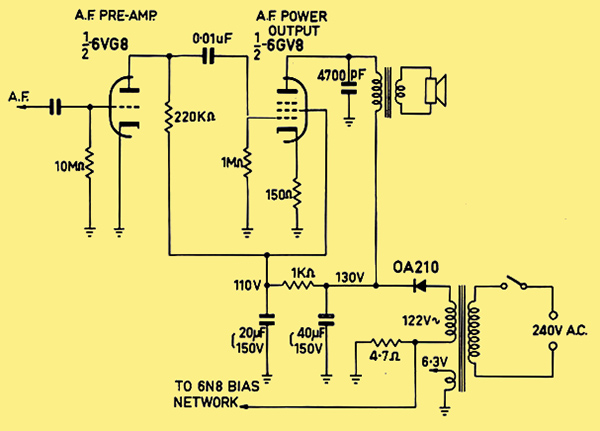|

Audio Amplifier and power supply.
The ECL85 (6GV8) and the 300 mA version PCL85 were specified by Philips in Europe for service in monochrome television receivers as the frame output stage only. However, Philips in Australia did supply audio ratings and this amplifier is based on those specifications - Ed.
This valve was intended for frame oscillator and output use in TV sets. The European number is ECL85, but a later higher rated version also exists, as the ECL805. The 300 mA series heater version PCL85/18GV8 and PCL805 would be more familiar. Because of the low anode voltage of this valve (as compared to typical 250 V types), one may wonder about using the pentode as an audio output valve with lower than normal HT voltage, while still obtaining good output power. As it happens, Philips in Australia did explore this possibility, as described in the Miniwatt Digest for March 1963.
Commercially, the 6GV8 was used as an audio amplifier in the Kriesler 11-99 mantel radio, and the Pye T23 TV set.
Note that the operating conditions in this amplifier are very similar to output valves often used in USA designed sets for AC/DC operation. For Australian constructors, the 6GV8 is an easier valve to obtain when wanting to duplicate such circuits, provided of course the heater supply is taken into account. This is 900 mA at 6.3 V.
The 6GV8 is suggested as AF amplifier in spite of the fact that this valve is particularly designed for vertical oscillator and output service. Closer investigation shows that such at valve, which in TV has to deliver high peak plate current at low plate voltage, is just the type suitable for AF power output service at low HT voltage. Since there is also a triode section in the 6GV8, this can be used as a pre-amplifier thus eliminating another valve.
The optimum operating conditions for the pentode section at 130 V anode supply and 110 V screen supply require a cathode resistor of 150 Ω and an anode load impedance of 2,000 Ω. The DC anode current is then 40 mA and the power output is 2.2 W at 11% THD. If feedback is applied by omitting the cathode bypass capacitor, and if a standard 9/16 in stack output transformer is used, approximately 1.4 W of output power can he expected in the voice coil.
Since both the triode amplification factor and pentode mutual conductance of the 6GV8 are lower than those of, say, a 6BD7-6M5 combination, the audio sensitivity will be lower - in the above case by a factor of two.
Thanks to John for the information. More can be found on his website.
|